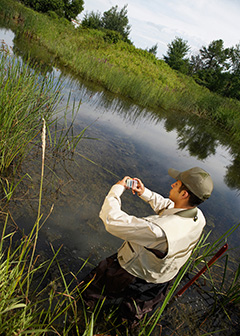How to Become an Environmental Science or Protection Technician About this section

Environmental science and protection technicians need an associate’s degree or comparable postsecondary training.
Environmental science and protection technicians need an associate’s degree or comparable postsecondary training for most jobs. New technicians are often trained on the job by more experienced environmental science and protection technicians.
Education
Most employers prefer applicants who have at least an associate’s degree, or 2 years of postsecondary training, in a natural science or science-related technology. However, some entry-level positions require a high school diploma.
Many technical and community colleges offer programs in environmental studies or a related technology, such as remote sensing or geographic information systems (GIS). Associate’s degree programs at community colleges are traditionally designed to provide easy transfer to bachelor’s degree programs at colleges and universities because a bachelor’s degree can be useful for future career advancement. Technical institutes usually offer technical training but provide less theory and general education than community colleges offer.
A well-rounded background in natural sciences is important for environmental science technicians, so students should take courses in chemistry, biology, geology, and physics. Coursework in mathematics, statistics, and computer science also is useful because technicians routinely do data analysis and modeling. Many schools offer internships and cooperative-education programs, which help students gain valuable experience while attending school. Internships and cooperative-education experience can enhance the students’ employment prospects.
Important Qualities
Analytical skills. Environmental science and protection technicians must be able to carry out a wide range of laboratory and field tests, and their results must be accurate and precise.
Critical-thinking skills. Environmental science and protection technicians reach their conclusions through sound reasoning and judgment. They have to be able to determine the best way to address environmental hazards.
Interpersonal skills. Environmental science and protection technicians need to be able to work well with others as part of a team, because they often work together with scientists and other technicians.
Listening skills. Environmental science and protection technicians must carefully follow instructions given to them by environmental scientists and specialists, because any mistakes can invalidate the results of their experiments and investigations.
Speaking skills. Environmental science and protection technicians must be able to discuss their results with clients and colleagues.
Writing skills. Environmental science and protection technicians must document the results of their work in written reports.
Training
Most environmental science and protection technicians receive on-the-job training. The length of training varies with the new employee’s level of experience and education.
Typically, experienced technicians teach new employees proper methods and procedures for conducting experiments, inspections, and other tasks. Technicians usually learn about relevant environmental and health regulations and standards as part of their training.
Licenses
In some states, environmental science and protection technicians need a license to do certain types of environmental and health inspections. For example, some states require licensing for technicians who test buildings for radon. Licensure requirements vary by state but typically include minimum levels of education and experience and a passing score on an exam.
Advancement
Technicians who have a bachelor’s degree are often able to advance to environmental scientist positions. For more information, see the profile on environmental scientists and specialists.












